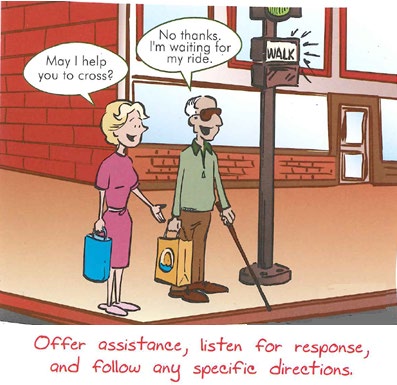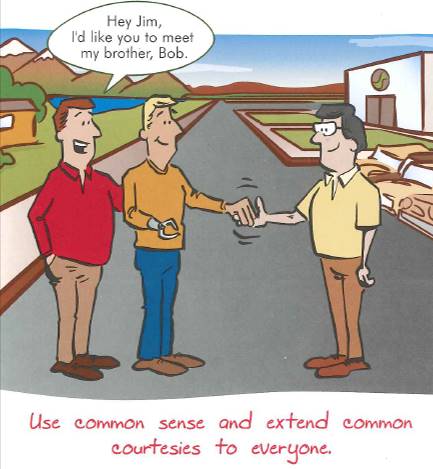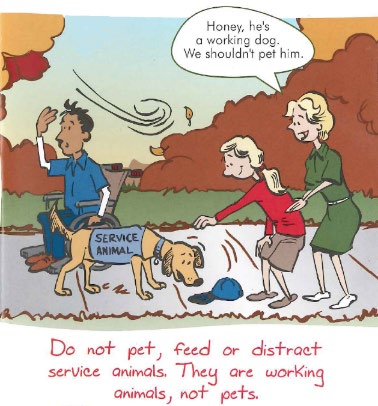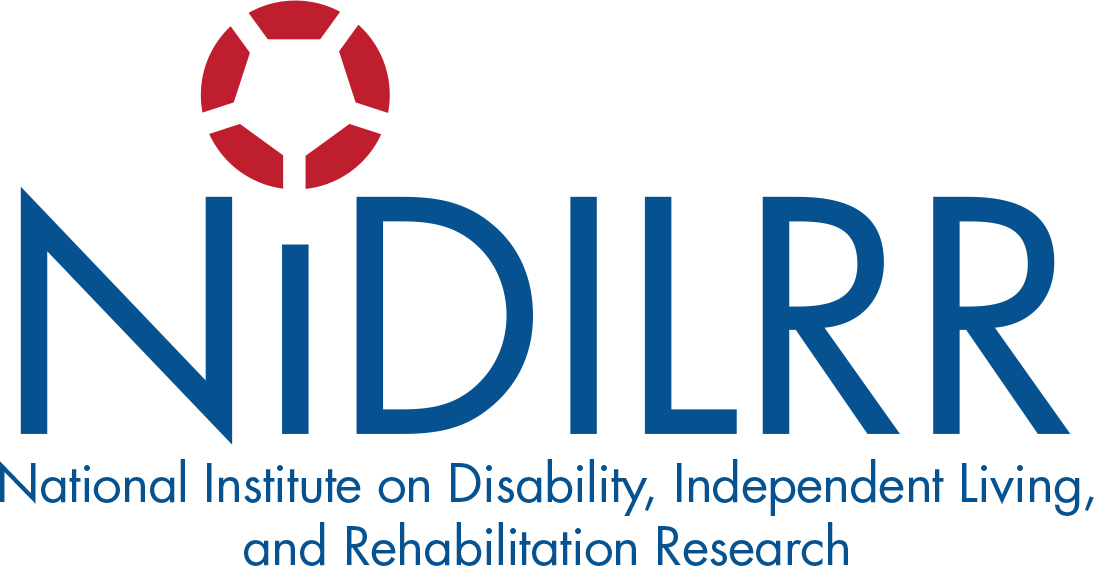Print-Friendly PDF | Large-Print PDF
This guidance sheet offers tips and advice from people who have disabilities to help put everyone at ease. Because no two people with disabilites are exactly alike, it is best to ask the person and follow the person's lead when it comes to what works best for them.

Respectful Language
People-first language is based on the idea that the person is not identified by their disability. An example of this is "People who are blind" instead of "Blind people."
Identity-first language means that the person feels that the disability is a strong part of who they are and they are proud of their disability. For example "Disabled person," versus "person who has a disability."
Ultimately, people with disabilities decide how their disability should be stated. Some may choose people first language, while others use identity first language. At this time, people-first language is recommended for use by anyone who doesn't have a disability and for professionals who are writing or speaking about people with disabilities.
| Terms generally discouraged | Terms generally recommended |
|---|---|
| a handicap | a disability |
| suffers from, afflicted by, victim of | has a disability |
| The handicapped, handi-capable, differently-abled | People with disabilities |
| Able-bodied, normal | People without disabilities |
| Mental retardation | Intellectual disability |
| Wheelchair bound | Person who uses a wheelchair; person with a mobility disability |
| Hearing impaired | Person who is deaf or hard of hearing |
| Mental illness, mental disorder, crazy, insane | psychiatric disability |
| Midget |
Person of short stature; little person; person with dwarfism |
| Epileptic | Person who has epilepsy; person who has seizures |
| fits, spells, attacks | seizures |
| Brain damaged | People with brain injuries |
| Slow learner | Person with a learning disability |
| Diabetics | People who have diabetes |
It is ok to use phrases such as "Want to go for a walk?" to a person who uses a wheelchair; "Have you seen...?" to an individual who is blind; or "Did you hear about...?" to an individual who is deaf. If you do not understand something an individual has said, perhaps because they have a communication disability, do not pretend to understand. Instead ask them to repeat it or to write it down.

General Etiquette
Treat people with disabilities as you would anyone else, while making reasonable accommodations. Consider universal design when planning activities. For example, dimmable room lighting, choice of large and small meeting rooms, scheduling more time for breaks, and offering information in different formats and handouts, written in plain language, can be very helpful to people with all types of disabilities. Before you hold an event, be sure to ask each guest what accommodation is needed (if any). Ask new employees if their work space gives them full access.

Do not use "baby-talk." Speak directly to the individual, no their companion, interpreter, or personal care attendant (PCA).
Do not touch, address, or feed a service animal unless you have the person's permission.
People who have a physical disability
A mobility device is a part of the individual's personal space. Do not lean on the device, use it as a coat hanger, or kick it. When speaking with a person who uses a wheelchair, stand back, kneel, or sit down to help alleviate their neck strain. Even if an individual does not have an arm or hand, hold out your own for a handshake. The individual will be used to this situation, and you may simply follow their lead.
People who are blind or have low vision
Identify yourself as you enter or leave a small work area. Use descriptive language when giving directions. instead of "the restrooms are over there," say "if you turn around, the restrooms are located down the second hallway, about 20 feet on the left." Let the individual know if you are holding out a pen to them, or similar. Put a card down at signature lines, so an individual can feel where to sign when needed. Identify paper money when handling it to a customer with a visual disability. Offer to read printed materials aloud.
For more information, visit Northwest ADA Center videos on YouTube.
 The contents of this fact sheet were developed under grant from the National Institute on Disability, Independent Living, and Rehabilitation Research (NIDILRR grant number 90DPAD0002). NIDILRR is a Center within the Administration for Community Living (ACL), Department of Health and Human Services (HHS). The contents of this fact sheet do not necessarily represent the policy of NIDILRR, ACL, or HHS, and you should not assume endorsement by the Federal Government. Alternative formats available upon request.
The contents of this fact sheet were developed under grant from the National Institute on Disability, Independent Living, and Rehabilitation Research (NIDILRR grant number 90DPAD0002). NIDILRR is a Center within the Administration for Community Living (ACL), Department of Health and Human Services (HHS). The contents of this fact sheet do not necessarily represent the policy of NIDILRR, ACL, or HHS, and you should not assume endorsement by the Federal Government. Alternative formats available upon request.
